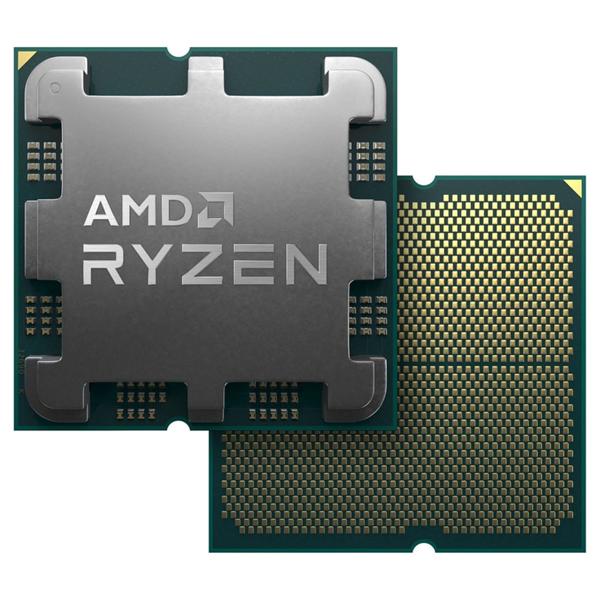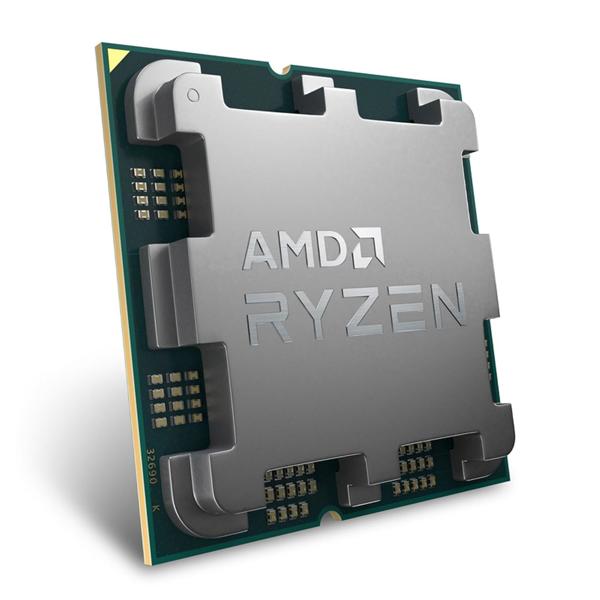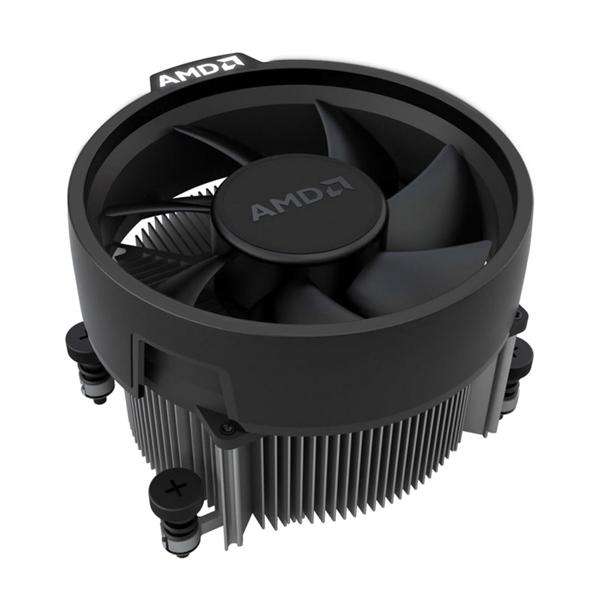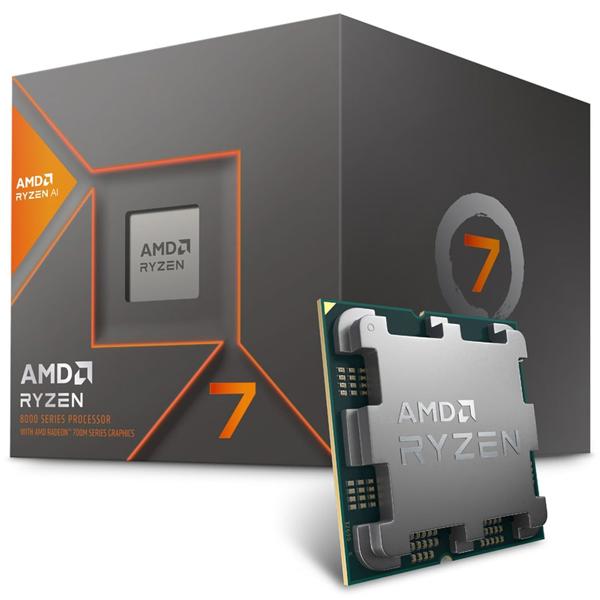







AMD RYZEN 7 8700G AM5
The AMD Ryzen 7 8700G is a high-performance processor featuring 8 cores and 16 threads, built on the Zen 3 architecture. With integrated Radeon Vega graphics, it delivers powerful performance for multitasking, light gaming, and productivity tasks.
Features
The AMD Ryzen 7 8700G is a powerful, mid-to-high range processor designed for users who need strong performance for multitasking, light gaming, and productivity tasks, all within compact form-factor systems. Featuring 8 cores and 16 threads, the Ryzen 7 8700G offers a compelling balance of efficiency and power, coupled with integrated Radeon Vega graphics, making it an excellent choice for users who prefer not to use a discrete graphics card but still need solid graphical capabilities for everyday tasks and casual gaming.
Core Specifications:
- Cores and Threads: The Ryzen 7 8700G features 8 cores and 16 threads, providing strong multi-threading performance ideal for demanding applications like video editing, 3D rendering, and running multiple applications simultaneously. This processor ensures a smooth experience for both general and intensive tasks, giving it an edge in performance compared to lower-end Ryzen chips.
- Base and Boost Clocks: The Ryzen 7 8700G has a base clock of 3.6 GHz and can boost up to 4.6 GHz. This enables quick responses in both single-threaded and multi-threaded workloads. The boost clock ensures higher performance during heavy tasks, while the base clock maintains a steady pace for regular computing operations, ensuring efficiency during lighter workloads.
- Cache: The processor is equipped with 20MB of cache (16MB L3 and 4MB L2), which helps to reduce latency and boost performance during tasks that require repeated access to data, like gaming or productivity work. The large cache ensures that the processor performs optimally in diverse applications, from general computing to creative work.
Architecture and Features:
- Zen 3 Architecture: Built on the efficient Zen 3 architecture, the Ryzen 7 8700G benefits from improved instructions per clock (IPC) performance, meaning it can handle tasks more efficiently compared to older generations. Zen 3 brings superior processing power and energy efficiency, which is crucial for users working in compact builds or those who prioritize power efficiency.
- 6nm Process Technology: Manufactured using a 6nm process, the Ryzen 7 8700G offers better power efficiency, lower thermal output, and more performance per watt than older processors. This allows the processor to maintain strong performance while using less power, making it a suitable option for systems with limited cooling or smaller cases.
- AM5 Socket and PCIe 5.0 Support: The Ryzen 7 8700G uses the AM5 socket, which provides compatibility with the latest generation of motherboards and future-proofing through support for PCIe 5.0. While the processor does not heavily rely on PCIe 5.0’s fast data transfer for its operations, users will still be able to take advantage of other modern technologies like faster storage and next-gen GPUs when upgrading to a discrete graphics card later.
Integrated Graphics:
- Radeon Vega Graphics: The Ryzen 7 8700G comes with integrated Radeon Vega graphics, which provide good performance for light gaming, media consumption, and GPU-accelerated tasks. While this processor is not designed to handle AAA gaming at high settings, its integrated Vega GPU can run older or less demanding games at 1080p resolution with medium settings and moderate frame rates. The Vega graphics also make it suitable for video streaming, photo editing, and other multimedia tasks without needing a dedicated graphics card.
Performance and Compatibility:
- Gaming Performance: The Ryzen 7 8700G is not intended for heavy gaming but can handle casual gaming and esports titles well thanks to its integrated Radeon Vega graphics. Users can expect smooth gameplay in popular games like Fortnite, League of Legends, and CS: GO at medium settings. It is best suited for gamers who do not require a discrete GPU but still want an enjoyable gaming experience.
- Productivity and Content Creation: With 8 cores and 16 threads, the Ryzen 7 8700G excels in productivity tasks like office work, video editing, photo editing, and web browsing with multiple applications open. For creative professionals, this processor can handle moderate video rendering, image manipulation, and other light-to-medium workloads in applications like Adobe Premiere Pro or Photoshop.
- Platform Compatibility: As part of the AM5 platform, the Ryzen 7 8700G is compatible with modern motherboards, which offer support for PCIe 5.0 and DDR5 memory. This compatibility ensures users have access to next-generation features while maintaining strong performance with the processor's integrated graphics.
Cooling and Power:
- Thermal Design Power (TDP): The Ryzen 7 8700G has a TDP of approximately 65W, making it suitable for compact systems and builds with limited space for cooling. It strikes a balance between power consumption and performance, allowing users to build more efficient systems while keeping thermal output under control.
- Cooling Solution: The Ryzen 7 8700G generally does not come with a bundled cooler, so users will need to install an aftermarket cooler for better thermal performance. Given its TDP and the efficiency of the 6nm process, moderate air or low-profile cooling solutions should suffice in most cases, though more demanding users may opt for liquid cooling in higher-performance builds.
Advanced Features:
- Overclocking Support: The Ryzen 7 8700G is unlocked for overclocking, allowing users to fine-tune the processor’s performance. While not specifically designed for extreme overclocking, it provides the flexibility to push the CPU's limits to achieve higher performance for tasks such as gaming or productivity applications.
- Precision Boost: The processor comes with AMD’s Precision Boost, a feature that dynamically adjusts the processor’s performance based on current workload demands. This ensures that the processor boosts clock speeds when necessary for heavy tasks and scales down power usage during lighter workloads, maintaining an optimal balance between performance and energy efficiency.
Specifications
| TOTAL NUMBER OF CORE | 8 |
|---|---|
| TOTAL NUMBER OF THREADS | 16 |
| MAX RAM MEMORY SUPPORT | 256 GB |
| MOTHERBOARD SUPPORT | 600 / 800 SERIES |
| RAM SUPPORT | DDR-5 UPTO 5200 MT/S |
| MAX MEMORY BANDWIDTH | 64 GB/S |
| PROCESSOR BASE FREQUENCY | 4.20 GHZ |
| PROCESSOR MAX TURBO FREQUENCY | UPTO 5.1 GHZ |
| SOCKET TYPE | AM5 |
| LITHOGRAPY | 4NM |
| THERMAL JUNCTION | 95°C |
| PCIe RIVISION | 4 |
| MAX NO. OF PCIe LANES | 20 |
| TOTAL CACHE | 24 MB |
| TOTAL L2 CACHE | 8 MB |
| TOTAL L3 CACHE | 16 MB |
| PROCESSOR BASE POWER | 45 W |
| PROCESSOR MAXIMUM TURBO POWER | 65 W |
| BUS SPEED | 16GT/S |
| INBUILT GRAPHIC PROCESSOR | YES |
| GPU NAME | AMD RADEON 780M |
| GPU MAX DYNAMIC FREQUENCY | 2900 |